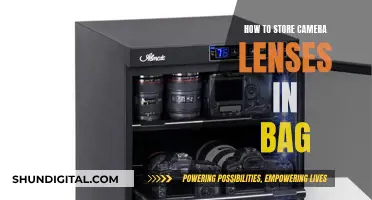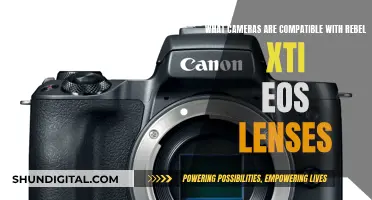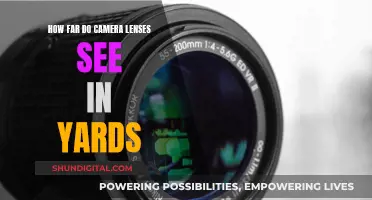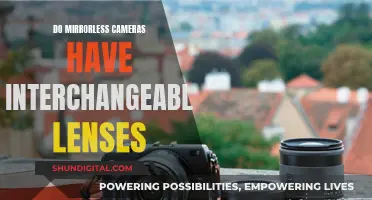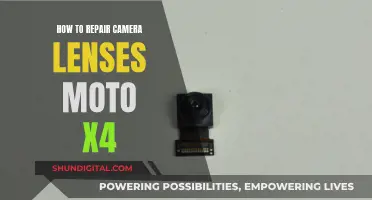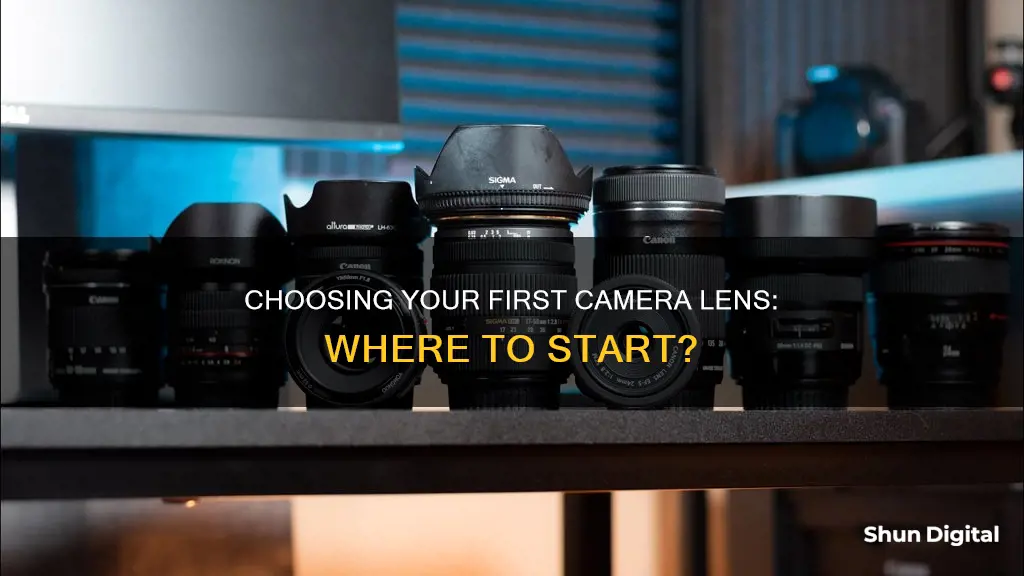
A starter camera lens, also known as a kit lens, is the default starter lens that comes bundled with an SLR camera body. It is a versatile lens that allows beginners to experiment with different types of photography, from landscapes to portraits, without needing to invest in multiple lenses right away. Kit lenses typically offer a versatile zoom range, such as 18-55mm or 18-140mm, covering a wide range of focal lengths. They are usually sold as part of a camera kit, making them more cost-effective, and they are designed to be user-friendly, with simple controls and autofocus capabilities. While kit lenses are a great starting point, they may have limitations in terms of aperture range, image quality, and low-light performance compared to higher-end lenses. As photographers gain experience, they may choose to invest in specialised lenses based on their specific needs and interests.
| Characteristics | Values |
|---|---|
| Type | Prime or Zoom |
| Focal Length | Variable, depending on the type of photography |
| Aperture | Variable, a wider aperture allows more light in |
| Compatibility | Check the lens mount to ensure it fits your camera |
| Size | Variable, smaller lenses are more comfortable for travel |
| Weight | Variable, lighter lenses are more comfortable for travel |
What You'll Learn

Prime vs Zoom Lenses
A prime lens has a fixed focal length and a single specified focal length, for example, 50mm. The only way to enlarge your subject and make it fill more of the frame is by physically getting closer to it. Conversely, the only way to fit more into the frame is to step back. Prime lenses are often smaller and lighter than zoom lenses.
A zoom lens has a variable focal length. You can change the focal length by turning the zoom ring, allowing you to make objects appear larger or smaller. Zoom lenses are often heavier and bulkier than prime lenses.
Advantages of Prime Lenses
- Prime lenses are often significantly cheaper than zoom lenses.
- Prime lenses are often smaller and lighter than zoom lenses.
- Prime lenses offer a wider aperture, allowing more light to enter the lens and creating a shallower depth of field, resulting in beautiful "bokeh".
- Prime lenses are often sharper than zoom lenses, especially at longer focal lengths.
- Prime lenses can help you learn composition and improve your technique by forcing you to "zoom with your feet".
Advantages of Zoom Lenses
- Zoom lenses offer versatility, allowing you to quickly change from wide-angle to telephoto without having to move.
- Zoom lenses often have image stabilisation, allowing you to use slower shutter speeds without introducing blur.
- Zoom lenses can reduce the need to carry multiple lenses, saving weight and the need to swap lenses.
The choice between a prime and a zoom lens depends on your needs and preferences. If you want a very shallow depth of field, a prime lens is ideal. If you need versatility, such as when travelling, a zoom lens is a better choice. It's also worth considering the type of photography you want to do. For example, a zoom lens is great for landscape and wildlife photography, while a prime lens is often preferred for portrait photography. Ultimately, both types of lenses have their advantages and disadvantages, and it's important to choose the one that best suits your shooting style and creative needs.
UV Light: Friend or Foe to Camera Lenses?
You may want to see also

Focal Length
The focal length also depends on the type of camera you are using. When using a full-frame camera, the focal length listed on the lens will be accurate. However, with crop-sensor cameras, the focal length will be longer than listed. For example, a 100mm focal length lens used on a Canon crop-sensor camera will function more like a 160mm focal length lens.
The right focal length for you will depend on your photography requirements. For example, if you want to fit more into your frame, a wide-angle lens might be the best option. On the other hand, if you want to get close to your subject, a telephoto lens with a longer focal length would be more suitable.
The Magic of Fikters for Your Camera Lenses
You may want to see also

Aperture
The aperture is usually specified as an f-number, the ratio of focal length to effective aperture diameter (the diameter of the entrance pupil). Aperture settings are given in full stops, such as f/16, or in 1/3 increments, such as f/3.5–5.6. The lower the f-number, the larger the aperture, and the more light is let into the camera. For example, f/2.8 is a larger aperture than f/4.
The aperture of a lens not only affects the brightness or exposure of your images but also the depth of field. A large aperture will give you a shallow depth of field, with a blurred background and sharp focus on the subject. This is often used for portrait photography. A small aperture will give you a wider depth of field, with the foreground and background in sharp focus. Landscape photographers often use a small aperture to ensure that both the foreground and background are in focus.
The aperture of a lens is also important in low-light photography. A lens with a large maximum aperture, such as f/1.4 or f/1.8, is considered a "fast" lens as it can pass through more light. This makes it ideal for low-light environments.
In summary, the aperture of a lens controls how much light reaches the camera sensor and can be adjusted to create different effects in your photographs, from bright and blurred to dark and sharply focused.
Camera Lenses: Reselling and Buying Used
You may want to see also

Compatibility
Digital cameras use sensors to record images, and there are two types of sensors available: the CCD (Charged-Couple Device) and the CMOS (Complementary Metal Oxide Semiconductor). The CMOS sensor is larger and can capture more light, resulting in higher-quality images than the CCD. Due to this size difference, your chosen lens should be compatible with your camera's sensor size and overall specifications.
Another aspect to consider is whether you have a crop sensor or full-frame camera. A full-frame camera will accurately reflect the focal length listed on your lens. On the other hand, crop-sensor cameras have a magnification factor, so the listed focal length will be shorter than the actual focal length in use. For example, a 100mm focal length lens on a Canon crop-sensor camera functions more like a 160mm focal length lens.
Most crop-sensor camera lenses are designed specifically for crop-sensor cameras, so ensure your chosen lens is compatible with your camera body.
Additionally, different camera brands may have unique features that affect lens compatibility. For instance, Nikon offers both a D and G version of their 50mm lens, and the G version, while more expensive, is compatible with all camera bodies, whereas the D version is not.
When purchasing a lens, always verify its compatibility with your camera model and be mindful of any brand-specific considerations.
Understanding Millimeters in Canon Camera Lenses
You may want to see also

Budget
When it comes to starter camera lenses, there are a few things to keep in mind if you're on a budget. Firstly, it's important to understand that you don't need to buy the most expensive lens on the market. As a beginner, you can start with a more affordable option that still offers good image quality.
- Prime lens: A 50mm prime lens, often called a "nifty fifty", is an excellent and versatile choice for beginners. It is usually relatively inexpensive and offers good image quality. The Canon EF 50mm f/1.8 STM Lens and the Nikon AF-S Nikkor 50mm f/1.8G are popular options.
- Zoom lens: If you want more flexibility, consider an 18-55mm or 18-135mm zoom lens. These lenses offer a range of focal lengths to experiment with and are suitable for various types of photography, from portraits to landscapes. The Canon EF-S 18-55mm f/4-5.6 IS STM and the Nikon 18-55mm f/3.5-5.6G VR are good options.
- Kit lens: Kit lenses that come with your camera can also be a great starting point. They offer a versatile zoom range, are easy to use, and allow you to focus on learning the basics of photography.
When choosing a starter lens, consider your specific needs and interests. For example, if you want to shoot portraits, a prime lens like the 50mm or 85mm is a good choice. For landscape photography, a wide-angle lens with a focal length of 14mm to 35mm is ideal. Additionally, consider factors such as aperture, size, weight, and compatibility with your camera.
Remember, as a beginner, it's important to start with a lens that fits your budget and helps you develop your photography skills. You can always upgrade to more expensive lenses as you gain experience and knowledge.
Best Camera Lenses for Long-Distance Shooting
You may want to see also
Frequently asked questions
A starter camera lens, also known as a kit lens, is the default "starter" lens that comes bundled with an SLR camera body. It is typically a versatile zoom lens with a range of focal lengths, such as 18-55mm or 28-105mm, allowing beginners to experiment with different types of photography. While kit lenses are affordable and user-friendly, they may have limitations in terms of aperture range, image quality, and low-light performance.
Prime lenses have a fixed focal length, such as 50mm, and offer sharper images, larger apertures, and faster autofocus. They are also smaller, lighter, and often more affordable than zoom lenses. Prime lenses are popular for portrait photography as they provide a beautiful depth-of-field effect and perform well in low-light conditions.
Zoom lenses offer a variable focal length, such as 18-200mm, allowing you to capture both wide and distant subjects without the need to carry multiple lenses. They are ideal for situations where you need to quickly adjust your composition, such as sports or wildlife photography. Zoom lenses are also useful for getting close-up shots while maintaining a comfortable distance from the subject.


